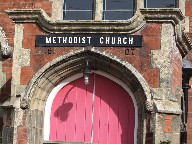| |
|
former
Methodist Chapel, Stokesby Methodism was the great enthusiasm
of the late 18th and early 19th Centuries, and was always
strong in rural, awkward, non-conformist east Norfolk.
But the labyrinthine world of the various Methodist
denominations before unification in 1932 can be a
confusing one. Unification itself, although no doubt a
noble thing spiritually and theologically, led to a great
cull of chapels which fell out of use as congregations
combined, and even in remote, rural areas the buildings
often fell prey to redevelopment. Stokesby Methodist
Church was built in 1907 by the Stokesby Primitve
Methodist Society with the help of funds granted by the
larger Acle Primitive Methodist Society up the road. Ben
Milner, in his excellent History of Methodism in East
Norfolk, notes that it replaced an earlier building,
but that in fact there was already a thriving Wesleyan
Methodist Society in Stokesby, with its own chapel
elsewhere in the village. In retrospect, the construction
of this fine little structure must have seemed like
empire-building, because already the Primitive Methodist
Society here was in decline, and by 1922 membership had
fallen to just seven people, and so this chapel closed.
However, seizing their chance, the busy Stokesby Wesleyan
Methodist Society bought the building for £250 and
reopened it for their own worship.
The chapel
is a smaller, simpler version of the typical design of
Primitive Methodist churches in the first decade of the
20th Century, with a large west window above the entrance
portico and flanking lancets. The corners of the
brickwork are neatly picked out with dressed stone. The
stained glass windows are a modern addition, of course,
for today this building is a private house.
| Most
villages in the Flegg still had their own
Methodist chapel after unification, but as Ben
Milner records, the beginning of the end came
when the chapel at nearby Filby was destroyed in
the great storm of October 1987 and was found to
be uninsured. The land was sold, and the
community soldiered on at Runham and Stokesby,
but Methodism has seen a faster decline in
numbers than any other denomination in England in
the last thirty years, and maintaining the two
surviving chapels was unsustainable. A mark of
the decline is that when Runham closed in 1986
the congregation had reduced to 15 people, who
moved in with the congregation at Stokesby;
however, by the start of the 21st Century there
were once again just seven people left in total,
and Stokesby chapel was closed and sold in 2002,
the surviving members moving in with the
congregation of the brand new chapel at Acle,
built partly with the proceeds of selling off
older chapels. And so an extraordinary period in
English religious history comes towards its end.
|
|
 |
|
|
|
